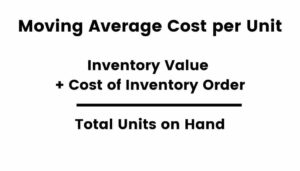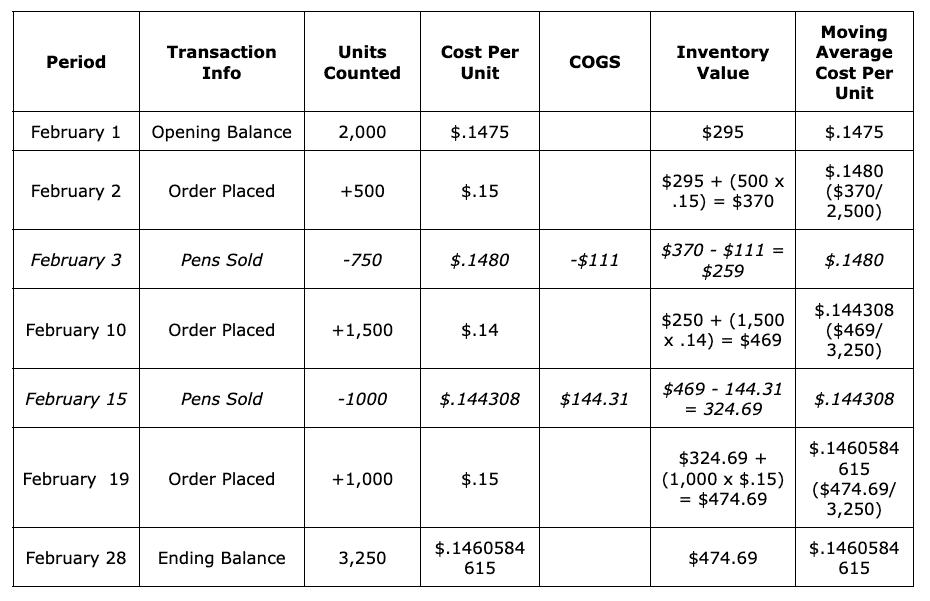If your business moves products from one location to another, you know all too well that transporting inventory doesn’t come free. Most companies work diligently to ensure they charge the right amount for shipping—or bake the correct costs into their product price should they offer free shipping to their customers. That’s where landing costs come in.
Simply put, moving average cost is the cost of existing inventory on hand plus the cost of new inventory ordered divided by the exact number of items in stock. Notably, moving average cost must be updated every time new inventory is purchased—otherwise, the calculations won’t reflect the “moving” average cost of items on hand. Moving average cost offers businesses an estimate of how much they’ve paid for a unit of inventory currently on hand. The calculation takes into account how much was spent on previous inventory, and factors in all purchases and sales of that item, too. Moving average cost is perfect for a business that goes through lots of inventory, especially if the price they pay for inventory changes frequently. In terms of inventory valuation methods, moving average cost is widely considered a reliable and conservative approach to determining inventory value. This matters because inventory valuation is a key line item on your company’s balance sheet—a key document used to determine your company’s financial health. Also known as the “moving average inventory method,” moving average cost is perfect for companies that practice perpetual inventory. That’s because by always knowing what they have on hand, these businesses can accurately determine how much they’ve spent on inventory and precisely how many units of inventory they have available. To practice perpetual inventory and calculate moving average cost properly, your business will need to use inventory management software to keep tabs on inventory as it comes and goes. Sometimes, inventory specialists or accountants may refer to moving average cost as “moving average price.”Moving Average Cost Definition
How to calculate moving average unit cost
The best way to calculate moving average cost is to keep track of every transaction: opening inventory, inventory purchase or sales, and closing inventory.
Moving average inventory method example
To make moving average cost easier to understand, let’s start with a hypothetical inventory transaction history that only includes purchases, not sales. Please note this example is oversimplified to demonstrate the basics of how this formula works.
Let’s say, for example, that a business that buys pens wholesale wants to calculate their moving average cost.
They begin the month of January with 1,000 pens on hand and a beginning inventory value of $150. The beginning cost per unit was $.15 a pen. Then, an order is placed for 500 more units at a cost of $.16 a pen. The next order is for 500 more pens, at $.13 a pen.
Finally, at the end of the transaction period, there are 2,000 pens on hand at an inventory value of $295.

Moving average cost formula
The moving average cost formula divides your current inventory value by the number of units in your current inventory. Note that the moving average price formula is the same.

When you use that formula with the numbers from the January ending balance shown in the ledger above, you’ll get:
$295 / 2,000 pens = $.1475 Moving Average Cost Per Pen
Now that you see how moving average cost was calculated at the end of the transaction period, let’s show you how to update your transaction history after every transaction. Remember, you won’t need to recalculate moving average cost after a sale, but you’ll need to use the most current moving average cost to calculate the cost of goods and sold and current inventory value.

In the table above, you’ll see the moving average cost of pens ($.1475 per unit) at the very end of the January period becomes the opening balance for the February accounting period. After that, the ledger reports every pen-related purchase or sale that transpired. Let’s walk through them all.
On February 2nd, the company orders 500 pens at $.15/pen. This pushes the moving average up to $.1480 per unit.
The next transaction, a sale on February 3rd, doesn’t change the moving average cost. But the current moving average cost is used to calculate the cost of goods sold and affects the current inventory value.
The next update to the actual moving average cost comes on February 10, when the business orders 1,500 pens at $.14 a unit. This transaction pushes the moving average cost down to $.144308. Once again, the next transaction, a sale, does not change the moving average cost.
Finally, the last transaction is February 19, when the company orders 1,000 more pens at $.15 apiece. This higher price per unit pushes the moving average cost to $.1460584615 per unit. Since this is the final transaction for the month, this number becomes the moving average cost on the final day of the period—and is used to calculate the ending inventory valuation.
When the March period opens, this final calculation becomes the opening inventory data. This includes the total units on hand, total inventory value, and moving average cost per unit.
How to use and interpret results
Moving average cost per unit can help you calculate all sorts of essential financial information, including the value of your inventory at a given moment in time. You can use this valuation to complete balance sheets, estimate inventory budgets, understand how much cash is sitting on your shelves, compute the cost of goods sold, and more.
You can also use moving average cost to conservatively gauge how much you are spending on certain items in your inventory. You can use this estimated cost per unit to compare against other suppliers’ price lists or compare your spending from period to period.
Related: How to find great, trustworthy suppliers
Calculating moving average cost with inventory management software
To calculate moving average cost accurately, you’ll need to update your inventory records every time you buy, sell, or consume inventory. You’ll also need to verify your beginning and ending inventory for each period.
To keep perpetual inventory, most businesses use an inventory app to streamline and automate their inventory processes. With inventory management software, you can scan barcodes and QR codes to check inventory in and out, speeding up inventory counting operations. This data will also help you calculate moving average costs faster.
You can also use your inventory software to generate reports quickly, attach purchase orders to item details, and set low stock alerts so you’ll remember to reorder inventory after it falls below a certain threshold.
About Sortly
Sortly is an end-to-end inventory solution that lets you organize, track, and manage your inventory from any device, in any location. Our easy-to-use mobile app lets you and your team update inventory on the job, scan barcodes from your smartphone, set low stock alerts to remind you to re-order, and more. That means you can work more efficiently, plan for jobs better, and serve your customers to their highest satisfaction.
If your company would benefit from improved inventory management, try Sortly free for 14 days.



